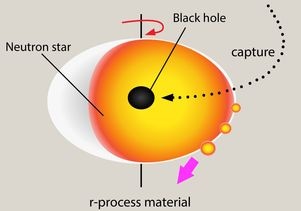Sep 4 2017
New theories proposed by UCLA Physicists focus on how the universe’s first black holes could have been formed and the role they could be playing in the development of heavy elements such as uranium, platinum and gold.
The journal Physical Review Letters featured two papers on their research.
 A black hole captured by a neutron star Credit: Alexander Kusenko/UCL
A black hole captured by a neutron star Credit: Alexander Kusenko/UCL
A question that has existed for a long time in the field of astrophysics is whether the universe's very first black holes came into existence less than a second after the Big Bang or whether they formed only millions of years later during the deaths of the earliest stars.
A compellingly simple new theory proposing that black holes could have been developed very shortly after the Big Bang, long before stars started to shine, was developed by Alexander Kusenko, a UCLA Professor of Physics, and Eric Cotner, a UCLA Graduate Student. Astronomers have earlier proposed that these primordial black holes are capable of accounting for some or all of the universe’s mysterious dark matter and that they have seeded the development of supermassive black holes that are present at the centers of galaxies. According to the new theory, primordial black holes may help produce a number of the heavier elements detected in nature.
The Researchers first considered the fact that a uniform field of energy saturated the universe shortly after the Big Bang. Scientists assume that such fields were present in the distant past. This energy field would have separated into clumps after the universe rapidly expanded. Gravity could allow these clumps to attract one another and then blend together. The UCLA Researchers suggested that a small fraction of these growing clumps became sufficiently dense in order to develop into black holes.
Kusenko stated that their hypothesis is fairly generic and that it does not depend on what he called the “unlikely coincidences” are responsible for underpinning other theories explaining primordial black holes.
The paper highlights the possibility of searching for primordial black holes using astronomical observations. One method deals with measuring the extremely small changes in a star’s brightness that result due to the gravitational effects of a primordial black hole traveling between Earth and that star. U.S. and Japanese Astronomers published a paper earlier this year, and this paper focused on their discovery of one star in a neighboring galaxy that brightened and dimmed accurately as if a primordial black hole was passing in front of it.
Kusenko, Volodymyr Takhistov, a UCLA Postdoctoral Researcher and George Fuller, a Professor at UC San Diego, in a separate study, suggested that primordial black holes could possibly play a vital role in the formation of heavy elements such as uranium, platinum, silver and gold, which could be constant in our galaxy and others.
For the Researchers, the origin of those heavy elements has been a mystery for a long time period.
Scientists know that these heavy elements exist, but they’re not sure where these elements are being formed. This has been really embarrassing.
Alexander Kusenko, a Professor of Physics, UCLA
The UCLA research proposes that a primordial black hole collides at times with a neutron star — the city-sized, spinning residue of a star that is left behind after a few supernova explosions — and then sinks into its depths.
According to Kusenko, when that occurs the primordial black hole consumes the neutron star from the inside, a process that takes almost 10,000 years. As the neutron star shrinks, it spins a lot faster, and finally causes small fragments to separate and fly off. Those fragments of neutron-rich material could be the sites in which neutrons fuse into heavier and heavier elements, Kusenko further stated.
Kusenko also stated that the likelihood of a neutron star capturing a black hole is reasonably low, which is steady with observations of just a few galaxies being enriched in heavy elements. The theory that primordial black holes crash against neutron stars to form heavy elements also explains the observed lack of neutron stars in the center of the Milky Way galaxy, a mystery that has prevailed for a long time in astrophysics.
Kusenko and his colleagues will collaborate this winter with Scientists at Princeton University on computer simulations of the heavy elements developed by a neutron star–black hole interaction. The Researchers compare the findings of those simulations with observations of heavy elements in neighboring galaxies in order to decide whether primordial black holes are definitely responsible for Earth’s platinum, uranium and gold.
The U.S. Department of Energy, the National Science Foundation and Japan’s World Premier International Research Center Initiative of the Ministry of Education, Culture, Sports, Science and Technology supported the research.